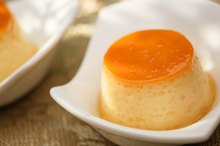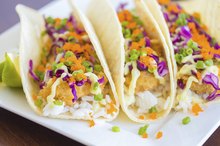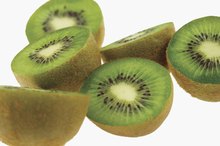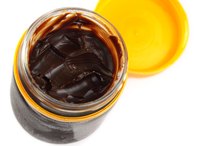What Is the Nutritional Value of Canned Mandarin Oranges?
Canned mandarin oranges are the preserved fruit of tangerine trees. The fruits are smaller than regular oranges with a rind and section membranes that peel easily to reveal tangy, sweet and succulent orange sections. These are then canned for sale and storage. A single serving of canned mandarin oranges provides significant amounts of vitamins, especially vitamins A and C, and minerals including zinc and copper.
Contents
A one-cup serving of canned mandarin oranges weighs 189 grams. According to the USDA Nutrient Database, 18 grams of this serving is carbohydrates with 16 grams of that amount coming from sugars. This serving also contains just 1 gram of protein and little appreciable fat. Water and other nutrients make up the remainder.
- A one-cup serving of canned mandarin oranges weighs 189 grams.
- According to the USDA Nutrient Database, 18 grams of this serving is carbohydrates with 16 grams of that amount coming from sugars.
Caloric Value
Flan Nutrition Information
Learn More
The USDA Nutrient Database indicates that a single cup of canned mandarin oranges delivers a total of 72 calories. Carbohydrates deliver the most at 66.4 calories per serving. Protein makes up around 4.8 calories and fat 0.6 calories. A single serving of canned mandarin orange has around 4 percent of the total daily caloric intake for the average person.
- The USDA Nutrient Database indicates that a single cup of canned mandarin oranges delivers a total of 72 calories.
- A single serving of canned mandarin orange has around 4 percent of the total daily caloric intake for the average person.
Vitamins
Canned mandarin oranges contain significant amounts of some vitamins. They are especially high in vitamins A, with 2480 IU or almost 90 percent the recommended daily amount, and vitamin C, with 64.1 mg or about 75 percent of what is needed per day in a one-cup serving. The same serving size also contains 0.2 milligrams of thiamine at 18 percent. Lower quantities of other vitamins in canned mandarin oranges include vitamin E, riboflavin, niacin, vitamin B6 and folate.
- Canned mandarin oranges contain significant amounts of some vitamins.
- Lower quantities of other vitamins in canned mandarin oranges include vitamin E, riboflavin, niacin, vitamin B6 and folate.
Minerals
Nutritional Information of Beef Ribs
Learn More
A one-cup serving of canned mandarin oranges also has small amounts of some dietary minerals. These include 1 milligram of zinc and 100 micrograms of copper, both at 11 percent the recommended daily amount, and 257 milligrams of potassium and 21 milligrams of magnesium, both at 5 percent of the daily requirement for the average adult. Trace quantities of calcium, iron, phosphorus and selenium are also found in canned mandarin oranges.
Other Information
A single, one-cup serving of canned mandarin oranges has 2.3 grams of dietary fiber and contains no cholesterol. A significant amount of the food value in canned mandarin oranges comes from sugar.
Related Articles
References
- Purdue University: Mandarin Orange
- Anwar S, Ahmed N, Speciale A, Cimino F, Saija A. Bitter Orange (Citrus Aurantium L.) Oils. InEssential Oils in Food Preservation, Flavor and Safety. Academic Press. 2016; 259-268.
- Uwague A. Phytochemical Screening and Proximate Analysis of Sweet Orange (Citrus Sinesis) Fruit Wastes. International Journal of Scientific Research in Science and Technology. 2017; 3(7).
- Orange, raw. FoodData Central. U.S Department of Agriculture. Published April 1, 2019.
- Agricultural Research Service. Oranges, raw. U.S. Department of Agriculture. 2019.
- Cleveland Clinic. Improving Your Health With Fiber. 2019.
- Harvard Health Publishing. Glycemic index for 60+ foods. Harvard Medical School. 2020.
- Centers for Disease Control and Prevention. How to Use Fruits and Vegetables to Help Manage Your Weight. 2020.
- UCSF Health. Cholesterol Content of Foods. University of California San Fransisco. 2020.
- Health Essentials. 3 Vitamins That Are Best for Boosting Your Immunity. Cleveland Clinic. 2020.
- Agriculture Research Service. Banana, raw. U.S. Department of Agriculture. 2019.
- Kaczmarczyk MM, Miller MJ, Freund GG. The health benefits of dietary fiber: beyond the usual suspects of type 2 diabetes mellitus, cardiovascular disease and colon cancer. Metabolism. 2012 Aug 1;61(8):1058-66. doi:10.1016/j.metabol.2012.01.017
- Gupta C, Prakash D. Phytonutrients as therapeutic agents. Journal of Complementary and Integrative Medicine. 2014 Sep 1;11(3):151-69. doi:10.1515/jcim-2013-0021
- National Institutes of Health Office of Dietary Supplements. Vitamin C: Fact sheet for consumers. 2019.
- American Heart Association. How potassium can help control high blood pressure. 2016.
- Juraschek SP, Guallar E, Appel LJ, Miller ER. Effects of vitamin C supplementation on blood pressure: A meta-analysis of randomized controlled trials. Am J Clin Nutr. 2012;95(5):1079-88. doi:10.3945/ajcn.111.027995
- National Institutes of Health. Office of Dietary Supplements. Thiamin: Fact Sheet for Health Professionals. 2019.
- Weikel KA, Garber C, Baburins A, Taylor A. Nutritional modulation of cataract. Nutr Rev. 2014;72(1):30-47. doi:10.1111/nure.12077
- Imbard A, Benoist JF, Blom HJ. Neural tube defects, folic acid and methylation. International journal of environmental research and public health. 2013 Sep;10(9):4352-89. doi:10.3390/ijerph10094352
- Iorio RA, Del Duca S, Calamelli E, Pula C, Lodolini M, Scamardella F, Pession A, Ricci G. Citrus allergy from pollen to clinical symptoms. PLoS One. 2013;8(1):e53680. doi:10.1371/journal.pone.0053680
- Hankinson A, Lloyd B, Alweis R. Lime-induced phytophotodermatitis. J Community Hosp Intern Med Perspect. 2014;4(4). doi:10.3402/jchimp.v4.25090
- Bailey DG, Dresser G, Arnold JM. Grapefruit–medication interactions: Forbidden fruit or avoidable consequences?. Cmaj. 2013 Mar 5;185(4):309-16. doi:10.1503/cmaj.120951
- Agriculture and Natural Resources. Oranges. University of California.
- Sir Elkhatim KA, Elagib RAA, Hassan AB. Content of phenolic compounds and vitamin C and antioxidant activity in wasted parts of Sudanese citrus fruits. Food Sci Nutr. 2018 May 8;6(5):1214-1219. doi:10.1002/fsn3.660
- UC Davis Health. Is Fruit Juice Bad for You and Your Children?
Writer Bio
In Jacksonville, Fla., Frank Whittemore is a content strategist with over a decade of experience as a hospital corpsman in the U.S. Navy and a licensed paramedic. He has over 15 years experience writing for several Fortune 500 companies. Whittemore writes on topics in medicine, nature, science, technology, the arts, cuisine, travel and sports.









